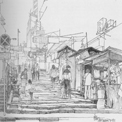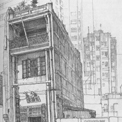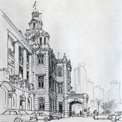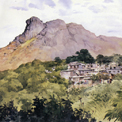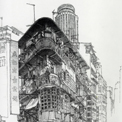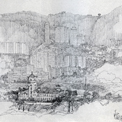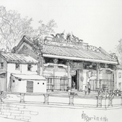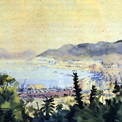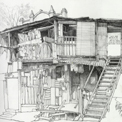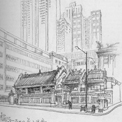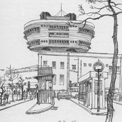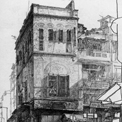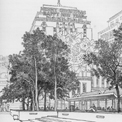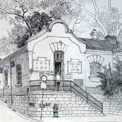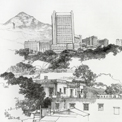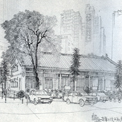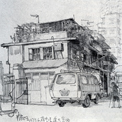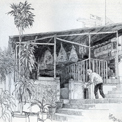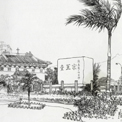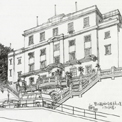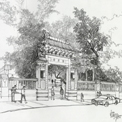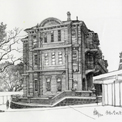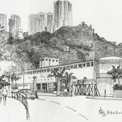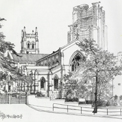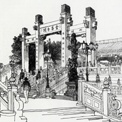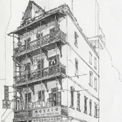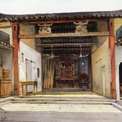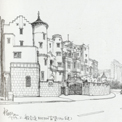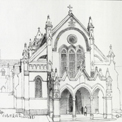Ma Wat Wai, Fanling
There are still many walled villages in the New Territories which are of historical heritage and have special characteristics of a traditional Chinese village. Fanling has five walled and six walled villages. In the early days, a wall surrounding the outside of a village was built because under the patriarchal system, extended families were rather usual. For security reasons, these walls were usually thick and high with a watch tower and a cannon porch, some even had a moat. Kat Hing Wai and Tsang Tai Uk are two walled villages that are better structured, but unfortunately, some rich villagers today have rebuilt some of these houses into Spanish villa, which seemed a little out of place.There are some almost deserted villages in the New Territories where only the elderly remain. Most of the villagers have either immigrated overseas or migrated to the urabn area. These villages are basically vacant, even delapidated, like Hok Tau Tsuen and Luk Keng Tsuen. The painting on the left shows Ma Wat Wai. The name "Ma Wat Wai" was granted by the government. According to the old villagers, the place was originally named "Wat Chung Wai〃("Wat Chung" in Chinese means a thick forest) because of the thick forest at the back. Since ancient writing was used to write the two characters "Wat Chung" (engraved on the lintel of the village), it may not be easy for government officials to recognize, and therefore, they gave the name "Ma Wat Wai" instead.
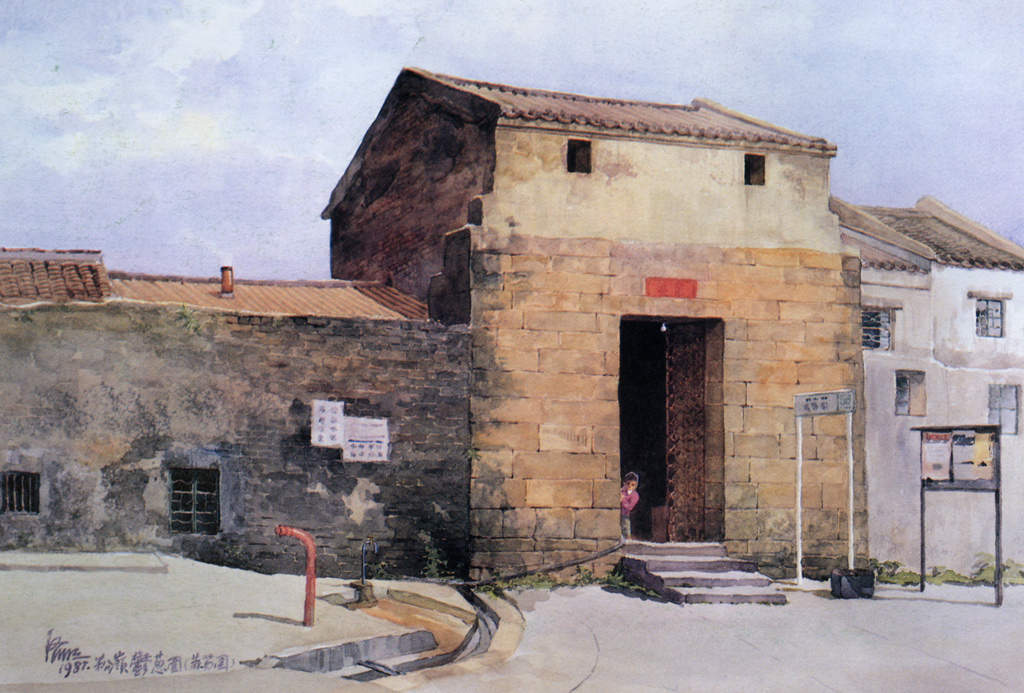
| Date | 1987 |
| Place | New Territories/North District/Fanling/Lung Yeuk Tau/Ma Wat Wai |
| people | Kong Kai Ming |
| Material Type | Image |
| Collection | Sketches by Kong Kai-ming |
| Source | Kong, Kai Ming. Landmarks of Hong Kong: Further Artistic Impression. (Hong Kong: The School of Continuing Education, Hong Kong Baptist University, 1994), p.62 |
| Repository | The University of Hong Kong Libraries |
| Note to Copyright | Permission for use is given by Kong Kai Ming |
| Accession No. | LA005-220 |
Ma Wat Wai, Fanling
There are still many walled villages in the New Territories which are of historical heritage and have special characteristics of a traditional Chinese village. Fanling has five walled and six walled villages. In the early days, a wall surrounding the outside of a village was built because under the patriarchal system, extended families were rather usual. For security reasons, these walls were usually thick and high with a watch tower and a cannon porch, some even had a moat. Kat Hing Wai and Tsang Tai Uk are two walled villages that are better structured, but unfortunately, some rich villagers today have rebuilt some of these houses into Spanish villa, which seemed a little out of place.There are some almost deserted villages in the New Territories where only the elderly remain. Most of the villagers have either immigrated overseas or migrated to the urabn area. These villages are basically vacant, even delapidated, like Hok Tau Tsuen and Luk Keng Tsuen. The painting on the left shows Ma Wat Wai. The name "Ma Wat Wai" was granted by the government. According to the old villagers, the place was originally named "Wat Chung Wai〃("Wat Chung" in Chinese means a thick forest) because of the thick forest at the back. Since ancient writing was used to write the two characters "Wat Chung" (engraved on the lintel of the village), it may not be easy for government officials to recognize, and therefore, they gave the name "Ma Wat Wai" instead.
| Date | 1987 |
| Place | New Territories/North District/Fanling/Lung Yeuk Tau/Ma Wat Wai |
| People | Kong Kai Ming |
| Material Type | Image |
| Collection | Sketches by Kong Kai-ming |
| Source | Kong, Kai Ming. Landmarks of Hong Kong: Further Artistic Impression. (Hong Kong: The School of Continuing Education, Hong Kong Baptist University, 1994), p.62 |
| Repository | The University of Hong Kong Libraries |
| Note to Copyright | Permission for use is given by Kong Kai Ming |
| Accession No. | LA005-220 |
Ma Wat Wai, Fanling
There are still many walled villages in the New Territories which are of historical heritage and have special characteristics of a traditional Chinese village. Fanling has five walled and six walled villages. In the early days, a wall surrounding the outside of a village was built because under the patriarchal system, extended families were rather usual. For security reasons, these walls were usually thick and high with a watch tower and a cannon porch, some even had a moat. Kat Hing Wai and Tsang Tai Uk are two walled villages that are better structured, but unfortunately, some rich villagers today have rebuilt some of these houses into Spanish villa, which seemed a little out of place.There are some almost deserted villages in the New Territories where only the elderly remain. Most of the villagers have either immigrated overseas or migrated to the urabn area. These villages are basically vacant, even delapidated, like Hok Tau Tsuen and Luk Keng Tsuen. The painting on the left shows Ma Wat Wai. The name "Ma Wat Wai" was granted by the government. According to the old villagers, the place was originally named "Wat Chung Wai〃("Wat Chung" in Chinese means a thick forest) because of the thick forest at the back. Since ancient writing was used to write the two characters "Wat Chung" (engraved on the lintel of the village), it may not be easy for government officials to recognize, and therefore, they gave the name "Ma Wat Wai" instead.
| Date | 1987 |
| Place | New Territories/North District/Fanling/Lung Yeuk Tau/Ma Wat Wai |
| People | Kong Kai Ming |
| Material Type | Image |
| Collection | Sketches by Kong Kai-ming |
| Source | Kong, Kai Ming. Landmarks of Hong Kong: Further Artistic Impression. (Hong Kong: The School of Continuing Education, Hong Kong Baptist University, 1994), p.62 |
| Repository | The University of Hong Kong Libraries |
| Note to Copyright | Permission for use is given by Kong Kai Ming |
| Accession No. | LA005-220 |
Ma Wat Wai, Fanling
There are still many walled villages in the New Territories which are of historical heritage and have special characteristics of a traditional Chinese village. Fanling has five walled and six walled villages. In the early days, a wall surrounding the outside of a village was built because under the patriarchal system, extended families were rather usual. For security reasons, these walls were usually thick and high with a watch tower and a cannon porch, some even had a moat. Kat Hing Wai and Tsang Tai Uk are two walled villages that are better structured, but unfortunately, some rich villagers today have rebuilt some of these houses into Spanish villa, which seemed a little out of place.There are some almost deserted villages in the New Territories where only the elderly remain. Most of the villagers have either immigrated overseas or migrated to the urabn area. These villages are basically vacant, even delapidated, like Hok Tau Tsuen and Luk Keng Tsuen. The painting on the left shows Ma Wat Wai. The name "Ma Wat Wai" was granted by the government. According to the old villagers, the place was originally named "Wat Chung Wai〃("Wat Chung" in Chinese means a thick forest) because of the thick forest at the back. Since ancient writing was used to write the two characters "Wat Chung" (engraved on the lintel of the village), it may not be easy for government officials to recognize, and therefore, they gave the name "Ma Wat Wai" instead.
| Date | 1987 |
| Place | New Territories/North District/Fanling/Lung Yeuk Tau/Ma Wat Wai |
| People | Kong Kai Ming |
| Material Type | Image |
| Collection | Sketches by Kong Kai-ming |
| Source | Kong, Kai Ming. Landmarks of Hong Kong: Further Artistic Impression. (Hong Kong: The School of Continuing Education, Hong Kong Baptist University, 1994), p.62 |
| Repository | The University of Hong Kong Libraries |
| Note to Copyright | Permission for use is given by Kong Kai Ming |
| Accession No. | LA005-220 |
Ma Wat Wai, Fanling
There are still many walled villages in the New Territories which are of historical heritage and have special characteristics of a traditional Chinese village. Fanling has five walled and six walled villages. In the early days, a wall surrounding the outside of a village was built because under the patriarchal system, extended families were rather usual. For security reasons, these walls were usually thick and high with a watch tower and a cannon porch, some even had a moat. Kat Hing Wai and Tsang Tai Uk are two walled villages that are better structured, but unfortunately, some rich villagers today have rebuilt some of these houses into Spanish villa, which seemed a little out of place.There are some almost deserted villages in the New Territories where only the elderly remain. Most of the villagers have either immigrated overseas or migrated to the urabn area. These villages are basically vacant, even delapidated, like Hok Tau Tsuen and Luk Keng Tsuen. The painting on the left shows Ma Wat Wai. The name "Ma Wat Wai" was granted by the government. According to the old villagers, the place was originally named "Wat Chung Wai〃("Wat Chung" in Chinese means a thick forest) because of the thick forest at the back. Since ancient writing was used to write the two characters "Wat Chung" (engraved on the lintel of the village), it may not be easy for government officials to recognize, and therefore, they gave the name "Ma Wat Wai" instead.
| Date | 1987 |
| People | Kong Kai Ming |
| Material Type | Image |
| Collection | Sketches by Kong Kai-ming |
| Source | Kong, Kai Ming. Landmarks of Hong Kong: Further Artistic Impression. (Hong Kong: The School of Continuing Education, Hong Kong Baptist University, 1994), p.62 |
| Repository | The University of Hong Kong Libraries |
| Note to Copyright | Permission for use is given by Kong Kai Ming |
| Accession No. | LA005-220 |
Ma Wat Wai, Fanling
There are still many walled villages in the New Territories which are of historical heritage and have special characteristics of a traditional Chinese village. Fanling has five walled and six walled villages. In the early days, a wall surrounding the outside of a village was built because under the patriarchal system, extended families were rather usual. For security reasons, these walls were usually thick and high with a watch tower and a cannon porch, some even had a moat. Kat Hing Wai and Tsang Tai Uk are two walled villages that are better structured, but unfortunately, some rich villagers today have rebuilt some of these houses into Spanish villa, which seemed a little out of place.There are some almost deserted villages in the New Territories where only the elderly remain. Most of the villagers have either immigrated overseas or migrated to the urabn area. These villages are basically vacant, even delapidated, like Hok Tau Tsuen and Luk Keng Tsuen. The painting on the left shows Ma Wat Wai. The name "Ma Wat Wai" was granted by the government. According to the old villagers, the place was originally named "Wat Chung Wai〃("Wat Chung" in Chinese means a thick forest) because of the thick forest at the back. Since ancient writing was used to write the two characters "Wat Chung" (engraved on the lintel of the village), it may not be easy for government officials to recognize, and therefore, they gave the name "Ma Wat Wai" instead.
| Date | 1987 |
| Place | New Territories/North District/Fanling/Lung Yeuk Tau/Ma Wat Wai |
| People | Kong Kai Ming |
| Material Type | Image |
| Collection | Sketches by Kong Kai-ming |
| Source | Kong, Kai Ming. Landmarks of Hong Kong: Further Artistic Impression. (Hong Kong: The School of Continuing Education, Hong Kong Baptist University, 1994), p.62 |
| Repository | The University of Hong Kong Libraries |
| Note to Copyright | Permission for use is given by Kong Kai Ming |
| Accession No. | LA005-220 |
Ma Wat Wai, Fanling
There are still many walled villages in the New Territories which are of historical heritage and have special characteristics of a traditional Chinese village. Fanling has five walled and six walled villages. In the early days, a wall surrounding the outside of a village was built because under the patriarchal system, extended families were rather usual. For security reasons, these walls were usually thick and high with a watch tower and a cannon porch, some even had a moat. Kat Hing Wai and Tsang Tai Uk are two walled villages that are better structured, but unfortunately, some rich villagers today have rebuilt some of these houses into Spanish villa, which seemed a little out of place.There are some almost deserted villages in the New Territories where only the elderly remain. Most of the villagers have either immigrated overseas or migrated to the urabn area. These villages are basically vacant, even delapidated, like Hok Tau Tsuen and Luk Keng Tsuen. The painting on the left shows Ma Wat Wai. The name "Ma Wat Wai" was granted by the government. According to the old villagers, the place was originally named "Wat Chung Wai〃("Wat Chung" in Chinese means a thick forest) because of the thick forest at the back. Since ancient writing was used to write the two characters "Wat Chung" (engraved on the lintel of the village), it may not be easy for government officials to recognize, and therefore, they gave the name "Ma Wat Wai" instead.
| Date | 1987 |
| Place | New Territories/North District/Fanling/Lung Yeuk Tau/Ma Wat Wai |
| People | Kong Kai Ming |
| Material Type | Image |
| Collection | Sketches by Kong Kai-ming |
| Source | Kong, Kai Ming. Landmarks of Hong Kong: Further Artistic Impression. (Hong Kong: The School of Continuing Education, Hong Kong Baptist University, 1994), p.62 |
| Repository | The University of Hong Kong Libraries |
| Note to Copyright | Permission for use is given by Kong Kai Ming |
| Accession No. | LA005-220 |
Ma Wat Wai, Fanling
There are still many walled villages in the New Territories which are of historical heritage and have special characteristics of a traditional Chinese village. Fanling has five walled and six walled villages. In the early days, a wall surrounding the outside of a village was built because under the patriarchal system, extended families were rather usual. For security reasons, these walls were usually thick and high with a watch tower and a cannon porch, some even had a moat. Kat Hing Wai and Tsang Tai Uk are two walled villages that are better structured, but unfortunately, some rich villagers today have rebuilt some of these houses into Spanish villa, which seemed a little out of place.There are some almost deserted villages in the New Territories where only the elderly remain. Most of the villagers have either immigrated overseas or migrated to the urabn area. These villages are basically vacant, even delapidated, like Hok Tau Tsuen and Luk Keng Tsuen. The painting on the left shows Ma Wat Wai. The name "Ma Wat Wai" was granted by the government. According to the old villagers, the place was originally named "Wat Chung Wai〃("Wat Chung" in Chinese means a thick forest) because of the thick forest at the back. Since ancient writing was used to write the two characters "Wat Chung" (engraved on the lintel of the village), it may not be easy for government officials to recognize, and therefore, they gave the name "Ma Wat Wai" instead.
| Date of Death | 1987 |
| Place | New Territories/North District/Fanling/Lung Yeuk Tau/Ma Wat Wai |
| People | Kong Kai Ming |
| Material Type | Image |
| Collection | Sketches by Kong Kai-ming |
| Source | Kong, Kai Ming. Landmarks of Hong Kong: Further Artistic Impression. (Hong Kong: The School of Continuing Education, Hong Kong Baptist University, 1994), p.62 |
| Repository | The University of Hong Kong Libraries |
| Note to Copyright | Permission for use is given by Kong Kai Ming |
| Accession No. | LA005-220 |
Ma Wat Wai, Fanling
There are still many walled villages in the New Territories which are of historical heritage and have special characteristics of a traditional Chinese village. Fanling has five walled and six walled villages. In the early days, a wall surrounding the outside of a village was built because under the patriarchal system, extended families were rather usual. For security reasons, these walls were usually thick and high with a watch tower and a cannon porch, some even had a moat. Kat Hing Wai and Tsang Tai Uk are two walled villages that are better structured, but unfortunately, some rich villagers today have rebuilt some of these houses into Spanish villa, which seemed a little out of place.There are some almost deserted villages in the New Territories where only the elderly remain. Most of the villagers have either immigrated overseas or migrated to the urabn area. These villages are basically vacant, even delapidated, like Hok Tau Tsuen and Luk Keng Tsuen. The painting on the left shows Ma Wat Wai. The name "Ma Wat Wai" was granted by the government. According to the old villagers, the place was originally named "Wat Chung Wai〃("Wat Chung" in Chinese means a thick forest) because of the thick forest at the back. Since ancient writing was used to write the two characters "Wat Chung" (engraved on the lintel of the village), it may not be easy for government officials to recognize, and therefore, they gave the name "Ma Wat Wai" instead.
| Date | 1987 |
| Material Type | Image |
| Collection | Sketches by Kong Kai-ming |
| Source | Kong, Kai Ming. Landmarks of Hong Kong: Further Artistic Impression. (Hong Kong: The School of Continuing Education, Hong Kong Baptist University, 1994), p.62 |
| Note to Copyright | Permission for use is given by Kong Kai Ming |
| Accession No. | LA005-220 |
Ma Wat Wai, Fanling
There are still many walled villages in the New Territories which are of historical heritage and have special characteristics of a traditional Chinese village. Fanling has five walled and six walled villages. In the early days, a wall surrounding the outside of a village was built because under the patriarchal system, extended families were rather usual. For security reasons, these walls were usually thick and high with a watch tower and a cannon porch, some even had a moat. Kat Hing Wai and Tsang Tai Uk are two walled villages that are better structured, but unfortunately, some rich villagers today have rebuilt some of these houses into Spanish villa, which seemed a little out of place.There are some almost deserted villages in the New Territories where only the elderly remain. Most of the villagers have either immigrated overseas or migrated to the urabn area. These villages are basically vacant, even delapidated, like Hok Tau Tsuen and Luk Keng Tsuen. The painting on the left shows Ma Wat Wai. The name "Ma Wat Wai" was granted by the government. According to the old villagers, the place was originally named "Wat Chung Wai〃("Wat Chung" in Chinese means a thick forest) because of the thick forest at the back. Since ancient writing was used to write the two characters "Wat Chung" (engraved on the lintel of the village), it may not be easy for government officials to recognize, and therefore, they gave the name "Ma Wat Wai" instead.
| Date | 1987 |
| Material Type | Image |
| Place | New Territories/North District/Fanling/Lung Yeuk Tau/Ma Wat Wai |
| People | Kong Kai Ming |
| Collection | Sketches by Kong Kai-ming |
| Source | Kong, Kai Ming. Landmarks of Hong Kong: Further Artistic Impression. (Hong Kong: The School of Continuing Education, Hong Kong Baptist University, 1994), p.62 |
| Repository | The University of Hong Kong Libraries |
| Note to Copyright | Permission for use is given by Kong Kai Ming |
| Accession No. | LA005-220 |
Ma Wat Wai, Fanling
There are still many walled villages in the New Territories which are of historical heritage and have special characteristics of a traditional Chinese village. Fanling has five walled and six walled villages. In the early days, a wall surrounding the outside of a village was built because under the patriarchal system, extended families were rather usual. For security reasons, these walls were usually thick and high with a watch tower and a cannon porch, some even had a moat. Kat Hing Wai and Tsang Tai Uk are two walled villages that are better structured, but unfortunately, some rich villagers today have rebuilt some of these houses into Spanish villa, which seemed a little out of place.There are some almost deserted villages in the New Territories where only the elderly remain. Most of the villagers have either immigrated overseas or migrated to the urabn area. These villages are basically vacant, even delapidated, like Hok Tau Tsuen and Luk Keng Tsuen. The painting on the left shows Ma Wat Wai. The name "Ma Wat Wai" was granted by the government. According to the old villagers, the place was originally named "Wat Chung Wai〃("Wat Chung" in Chinese means a thick forest) because of the thick forest at the back. Since ancient writing was used to write the two characters "Wat Chung" (engraved on the lintel of the village), it may not be easy for government officials to recognize, and therefore, they gave the name "Ma Wat Wai" instead.
| Date | 1987 |
| Place | New Territories/North District/Fanling/Lung Yeuk Tau/Ma Wat Wai |
| People | Kong Kai Ming |
| Material Type | Image |
| Collection | Sketches by Kong Kai-ming |
| Source | Kong, Kai Ming. Landmarks of Hong Kong: Further Artistic Impression. (Hong Kong: The School of Continuing Education, Hong Kong Baptist University, 1994), p.62 |
| Repository | The University of Hong Kong Libraries |
| Note to Copyright | Permission for use is given by Kong Kai Ming |
| Accession No. | LA005-220 |
Ma Wat Wai, Fanling
There are still many walled villages in the New Territories which are of historical heritage and have special characteristics of a traditional Chinese village. Fanling has five walled and six walled villages. In the early days, a wall surrounding the outside of a village was built because under the patriarchal system, extended families were rather usual. For security reasons, these walls were usually thick and high with a watch tower and a cannon porch, some even had a moat. Kat Hing Wai and Tsang Tai Uk are two walled villages that are better structured, but unfortunately, some rich villagers today have rebuilt some of these houses into Spanish villa, which seemed a little out of place.There are some almost deserted villages in the New Territories where only the elderly remain. Most of the villagers have either immigrated overseas or migrated to the urabn area. These villages are basically vacant, even delapidated, like Hok Tau Tsuen and Luk Keng Tsuen. The painting on the left shows Ma Wat Wai. The name "Ma Wat Wai" was granted by the government. According to the old villagers, the place was originally named "Wat Chung Wai〃("Wat Chung" in Chinese means a thick forest) because of the thick forest at the back. Since ancient writing was used to write the two characters "Wat Chung" (engraved on the lintel of the village), it may not be easy for government officials to recognize, and therefore, they gave the name "Ma Wat Wai" instead.
| Date | 1987 |
| Place | New Territories/North District/Fanling/Lung Yeuk Tau/Ma Wat Wai |
| People | Kong Kai Ming |
| Material Type | Image |
| Collection | Sketches by Kong Kai-ming |
| Source | Kong, Kai Ming. Landmarks of Hong Kong: Further Artistic Impression. (Hong Kong: The School of Continuing Education, Hong Kong Baptist University, 1994), p.62 |
| Repository | The University of Hong Kong Libraries |
| Note to Copyright | Permission for use is given by Kong Kai Ming |
| Accession No. | LA005-220 |
Ma Wat Wai, Fanling
There are still many walled villages in the New Territories which are of historical heritage and have special characteristics of a traditional Chinese village. Fanling has five walled and six walled villages. In the early days, a wall surrounding the outside of a village was built because under the patriarchal system, extended families were rather usual. For security reasons, these walls were usually thick and high with a watch tower and a cannon porch, some even had a moat. Kat Hing Wai and Tsang Tai Uk are two walled villages that are better structured, but unfortunately, some rich villagers today have rebuilt some of these houses into Spanish villa, which seemed a little out of place.There are some almost deserted villages in the New Territories where only the elderly remain. Most of the villagers have either immigrated overseas or migrated to the urabn area. These villages are basically vacant, even delapidated, like Hok Tau Tsuen and Luk Keng Tsuen. The painting on the left shows Ma Wat Wai. The name "Ma Wat Wai" was granted by the government. According to the old villagers, the place was originally named "Wat Chung Wai〃("Wat Chung" in Chinese means a thick forest) because of the thick forest at the back. Since ancient writing was used to write the two characters "Wat Chung" (engraved on the lintel of the village), it may not be easy for government officials to recognize, and therefore, they gave the name "Ma Wat Wai" instead.
| Date | 1987 |
| Place | New Territories/North District/Fanling/Lung Yeuk Tau/Ma Wat Wai |
| People | Kong Kai Ming |
| Material Type | Image |
| Collection | Sketches by Kong Kai-ming |
| Source | Kong, Kai Ming. Landmarks of Hong Kong: Further Artistic Impression. (Hong Kong: The School of Continuing Education, Hong Kong Baptist University, 1994), p.62 |
| Repository | The University of Hong Kong Libraries |
| Note to Copyright | Permission for use is given by Kong Kai Ming |
| Accession No. | LA005-220 |
Ma Wat Wai, Fanling
There are still many walled villages in the New Territories which are of historical heritage and have special characteristics of a traditional Chinese village. Fanling has five walled and six walled villages. In the early days, a wall surrounding the outside of a village was built because under the patriarchal system, extended families were rather usual. For security reasons, these walls were usually thick and high with a watch tower and a cannon porch, some even had a moat. Kat Hing Wai and Tsang Tai Uk are two walled villages that are better structured, but unfortunately, some rich villagers today have rebuilt some of these houses into Spanish villa, which seemed a little out of place.There are some almost deserted villages in the New Territories where only the elderly remain. Most of the villagers have either immigrated overseas or migrated to the urabn area. These villages are basically vacant, even delapidated, like Hok Tau Tsuen and Luk Keng Tsuen. The painting on the left shows Ma Wat Wai. The name "Ma Wat Wai" was granted by the government. According to the old villagers, the place was originally named "Wat Chung Wai〃("Wat Chung" in Chinese means a thick forest) because of the thick forest at the back. Since ancient writing was used to write the two characters "Wat Chung" (engraved on the lintel of the village), it may not be easy for government officials to recognize, and therefore, they gave the name "Ma Wat Wai" instead.
| Date | 1987 |
| Place | New Territories/North District/Fanling/Lung Yeuk Tau/Ma Wat Wai |
| People | Kong Kai Ming |
| Material Type | Image |
| Collection | Sketches by Kong Kai-ming |
| Source | Kong, Kai Ming. Landmarks of Hong Kong: Further Artistic Impression. (Hong Kong: The School of Continuing Education, Hong Kong Baptist University, 1994), p.62 |
| Repository | The University of Hong Kong Libraries |
| Note to Copyright | Permission for use is given by Kong Kai Ming |
| Accession No. | LA005-220 |
Ma Wat Wai, Fanling
There are still many walled villages in the New Territories which are of historical heritage and have special characteristics of a traditional Chinese village. Fanling has five walled and six walled villages. In the early days, a wall surrounding the outside of a village was built because under the patriarchal system, extended families were rather usual. For security reasons, these walls were usually thick and high with a watch tower and a cannon porch, some even had a moat. Kat Hing Wai and Tsang Tai Uk are two walled villages that are better structured, but unfortunately, some rich villagers today have rebuilt some of these houses into Spanish villa, which seemed a little out of place.There are some almost deserted villages in the New Territories where only the elderly remain. Most of the villagers have either immigrated overseas or migrated to the urabn area. These villages are basically vacant, even delapidated, like Hok Tau Tsuen and Luk Keng Tsuen. The painting on the left shows Ma Wat Wai. The name "Ma Wat Wai" was granted by the government. According to the old villagers, the place was originally named "Wat Chung Wai〃("Wat Chung" in Chinese means a thick forest) because of the thick forest at the back. Since ancient writing was used to write the two characters "Wat Chung" (engraved on the lintel of the village), it may not be easy for government officials to recognize, and therefore, they gave the name "Ma Wat Wai" instead.
| Date | 1987 |
| Place | New Territories/North District/Fanling/Lung Yeuk Tau/Ma Wat Wai |
| People | Kong Kai Ming |
| Material Type | Image |
| Collection | Sketches by Kong Kai-ming |
| Source | Kong, Kai Ming. Landmarks of Hong Kong: Further Artistic Impression. (Hong Kong: The School of Continuing Education, Hong Kong Baptist University, 1994), p.62 |
| Repository | The University of Hong Kong Libraries |
| Note to Copyright | Permission for use is given by Kong Kai Ming |
| Accession No. | LA005-220 |
Ma Wat Wai, Fanling
There are still many walled villages in the New Territories which are of historical heritage and have special characteristics of a traditional Chinese village. Fanling has five walled and six walled villages. In the early days, a wall surrounding the outside of a village was built because under the patriarchal system, extended families were rather usual. For security reasons, these walls were usually thick and high with a watch tower and a cannon porch, some even had a moat. Kat Hing Wai and Tsang Tai Uk are two walled villages that are better structured, but unfortunately, some rich villagers today have rebuilt some of these houses into Spanish villa, which seemed a little out of place.There are some almost deserted villages in the New Territories where only the elderly remain. Most of the villagers have either immigrated overseas or migrated to the urabn area. These villages are basically vacant, even delapidated, like Hok Tau Tsuen and Luk Keng Tsuen. The painting on the left shows Ma Wat Wai. The name "Ma Wat Wai" was granted by the government. According to the old villagers, the place was originally named "Wat Chung Wai〃("Wat Chung" in Chinese means a thick forest) because of the thick forest at the back. Since ancient writing was used to write the two characters "Wat Chung" (engraved on the lintel of the village), it may not be easy for government officials to recognize, and therefore, they gave the name "Ma Wat Wai" instead.
| Date | 1987 |
| Place | New Territories/North District/Fanling/Lung Yeuk Tau/Ma Wat Wai |
| People | Kong Kai Ming |
| Material Type | Image |
| Collection | Sketches by Kong Kai-ming |
| Source | Kong, Kai Ming. Landmarks of Hong Kong: Further Artistic Impression. (Hong Kong: The School of Continuing Education, Hong Kong Baptist University, 1994), p.62 |
| Repository | The University of Hong Kong Libraries |
| Note to Copyright | Permission for use is given by Kong Kai Ming |
| Accession No. | LA005-220 |
Ma Wat Wai, Fanling
There are still many walled villages in the New Territories which are of historical heritage and have special characteristics of a traditional Chinese village. Fanling has five walled and six walled villages. In the early days, a wall surrounding the outside of a village was built because under the patriarchal system, extended families were rather usual. For security reasons, these walls were usually thick and high with a watch tower and a cannon porch, some even had a moat. Kat Hing Wai and Tsang Tai Uk are two walled villages that are better structured, but unfortunately, some rich villagers today have rebuilt some of these houses into Spanish villa, which seemed a little out of place.There are some almost deserted villages in the New Territories where only the elderly remain. Most of the villagers have either immigrated overseas or migrated to the urabn area. These villages are basically vacant, even delapidated, like Hok Tau Tsuen and Luk Keng Tsuen. The painting on the left shows Ma Wat Wai. The name "Ma Wat Wai" was granted by the government. According to the old villagers, the place was originally named "Wat Chung Wai〃("Wat Chung" in Chinese means a thick forest) because of the thick forest at the back. Since ancient writing was used to write the two characters "Wat Chung" (engraved on the lintel of the village), it may not be easy for government officials to recognize, and therefore, they gave the name "Ma Wat Wai" instead.
| Date | 1987 |
| Place | New Territories/North District/Fanling/Lung Yeuk Tau/Ma Wat Wai |
| People | Kong Kai Ming |
| Material Type | Image |
| Collection | Sketches by Kong Kai-ming |
| Source | Kong, Kai Ming. Landmarks of Hong Kong: Further Artistic Impression. (Hong Kong: The School of Continuing Education, Hong Kong Baptist University, 1994), p.62 |
| Repository | The University of Hong Kong Libraries |
| Note to Copyright | Permission for use is given by Kong Kai Ming |
| Accession No. | LA005-220 |
Ma Wat Wai, Fanling
There are still many walled villages in the New Territories which are of historical heritage and have special characteristics of a traditional Chinese village. Fanling has five walled and six walled villages. In the early days, a wall surrounding the outside of a village was built because under the patriarchal system, extended families were rather usual. For security reasons, these walls were usually thick and high with a watch tower and a cannon porch, some even had a moat. Kat Hing Wai and Tsang Tai Uk are two walled villages that are better structured, but unfortunately, some rich villagers today have rebuilt some of these houses into Spanish villa, which seemed a little out of place.There are some almost deserted villages in the New Territories where only the elderly remain. Most of the villagers have either immigrated overseas or migrated to the urabn area. These villages are basically vacant, even delapidated, like Hok Tau Tsuen and Luk Keng Tsuen. The painting on the left shows Ma Wat Wai. The name "Ma Wat Wai" was granted by the government. According to the old villagers, the place was originally named "Wat Chung Wai〃("Wat Chung" in Chinese means a thick forest) because of the thick forest at the back. Since ancient writing was used to write the two characters "Wat Chung" (engraved on the lintel of the village), it may not be easy for government officials to recognize, and therefore, they gave the name "Ma Wat Wai" instead.
| Date | 1987 |
| Place | New Territories/North District/Fanling/Lung Yeuk Tau/Ma Wat Wai |
| People | Kong Kai Ming |
| Material Type | Image |
| Collection | Sketches by Kong Kai-ming |
| Source | Kong, Kai Ming. Landmarks of Hong Kong: Further Artistic Impression. (Hong Kong: The School of Continuing Education, Hong Kong Baptist University, 1994), p.62 |
| Repository | The University of Hong Kong Libraries |
| Note to Copyright | Permission for use is given by Kong Kai Ming |
| Accession No. | LA005-220 |
Copyright © 2012 Hong Kong Memory



